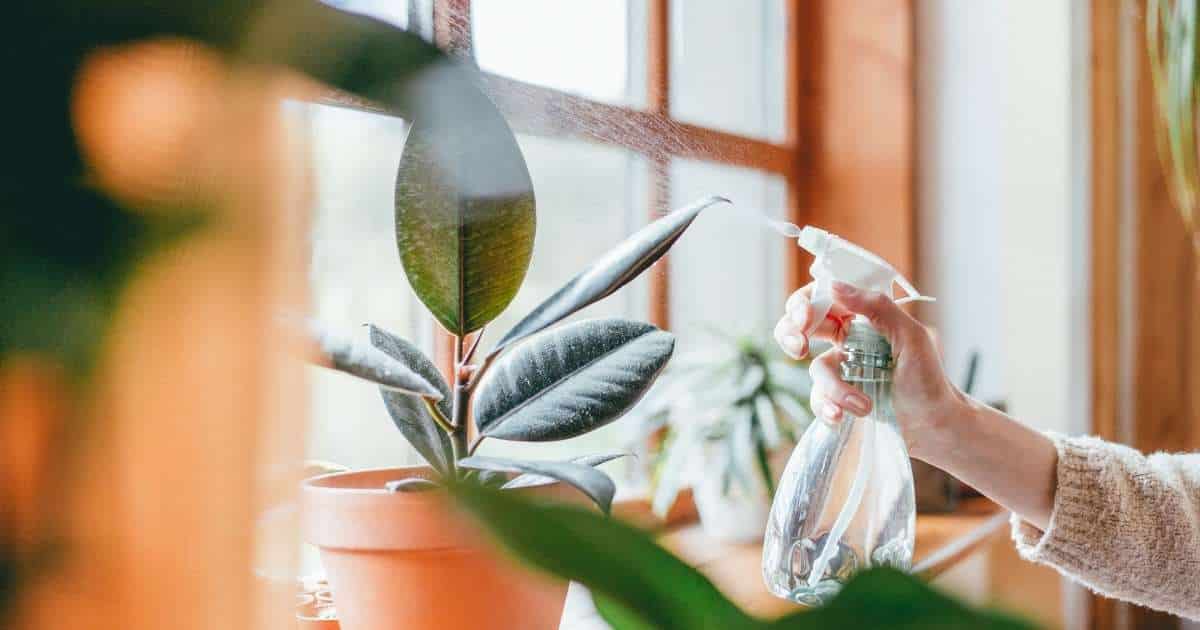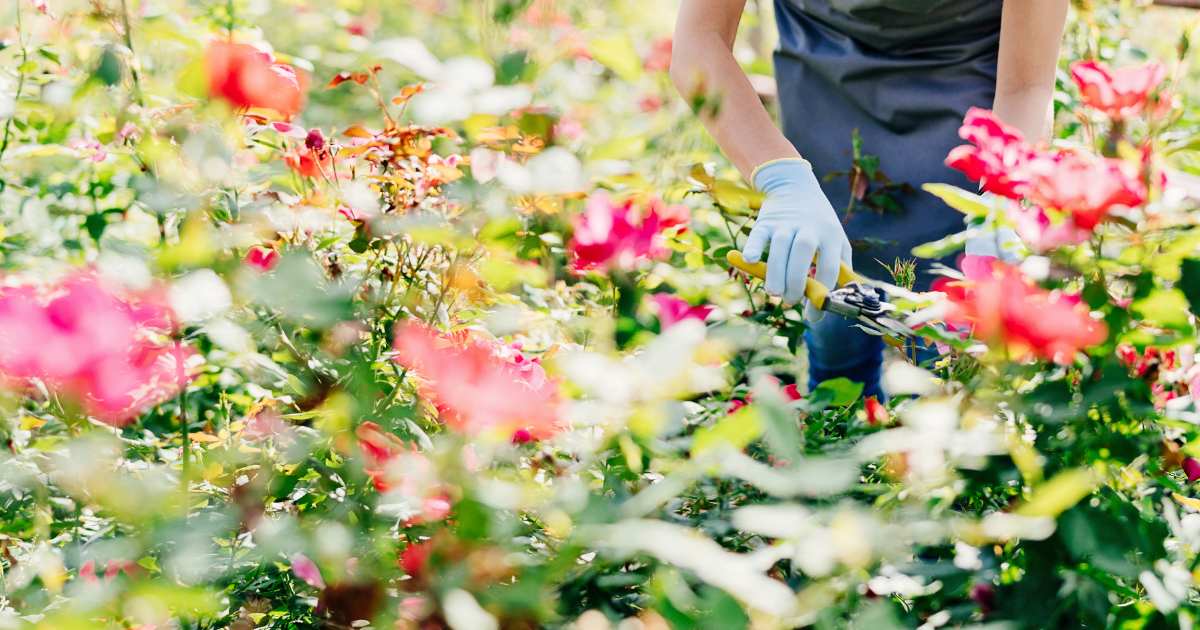Rock a Raised Bed Garden Arizona Style! (In 6 Easy Steps)
Hey there, fellow desert dwellers! 🌵
Welcome to your ultimate guide to starting a raised bed garden, Arizona Style!
If you are curious about raised garden beds, are considering starting a garden, and live in Arizona, you’ve landed at the right spot.
Today, I will go over everything you need to know about starting a raised garden in the desert, including a step-by-step guide on how to plant a raised bed garden from start to finish, along with the best-raised garden beds available and the best plants that love the Arizona heat.
Ready to get your hands dirty? Let’s dive into the world of raised garden beds Arizona style!
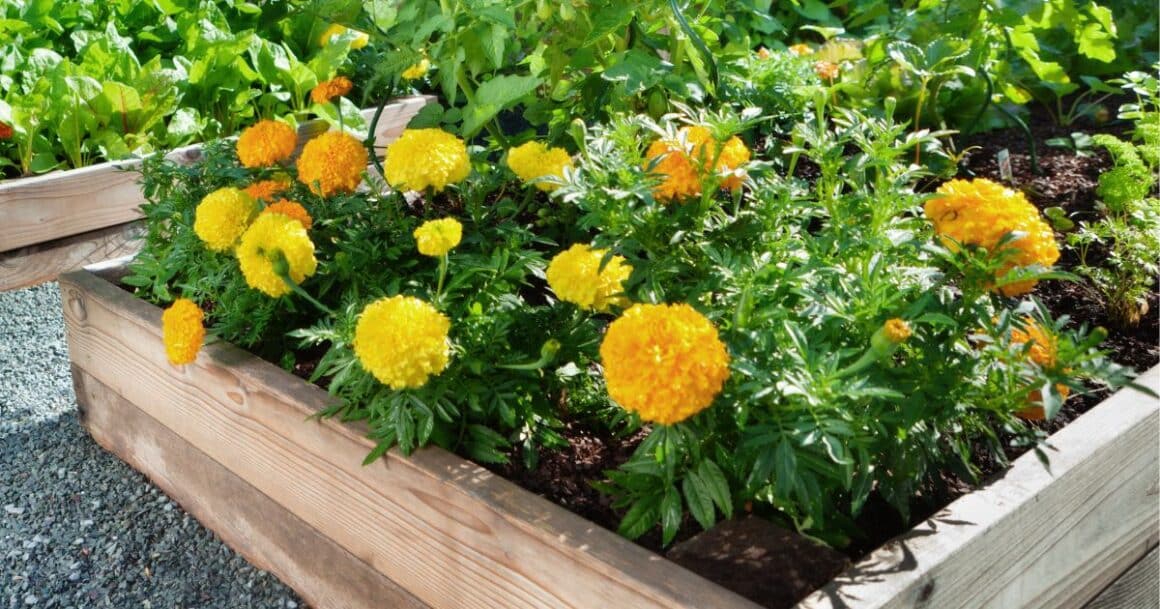
The Beauty of a Raised Garden Bed
A raised garden bed is a garden plot elevated above the surrounding ground level, typically enclosed by a frame made of wood, stone, metal, or other materials.
Instead of planting directly into the ground, gardeners fill these frames with a soil mix tailored to the needs of the plants they wish to grow.
The Benefits of Raised Garden Beds
Planting raised garden beds has many benefits over the traditional in-ground gardening bed method.
Improved Soil Quality: Allows customized soil mixtures, ensuring optimal pH, texture, and nutrient levels.
Better Drainage: Elevated soil prevents waterlogging and promotes better plant root health.
Easier Weed Management: The raised garden bed liner creates separation from the ground because the raised soil reduces the invasion of weeds.
Pest Control: Raised beds can deter certain pests, like snails, slugs, and some soil-borne diseases.
Extended Growing Season: Soil in raised beds warms up faster in the spring, allowing for earlier planting.
Ergonomic height: Easy access! Elevated design reduces excessive bending and kneeling, making gardening more accessible and reducing strain on the back and knees. 🙂
Versatility: Suitable for patios, rooftops, or areas with poor native soil.
Aesthetic Appeal: Provides a neat, organized appearance and can be a design feature in landscapes.
Crop Rotation: Raised beds make it easier to practice crop rotation, which can help prevent soil-borne diseases and improve soil fertility.
Water Conservation: Efficient watering is possible, reducing water wastage.
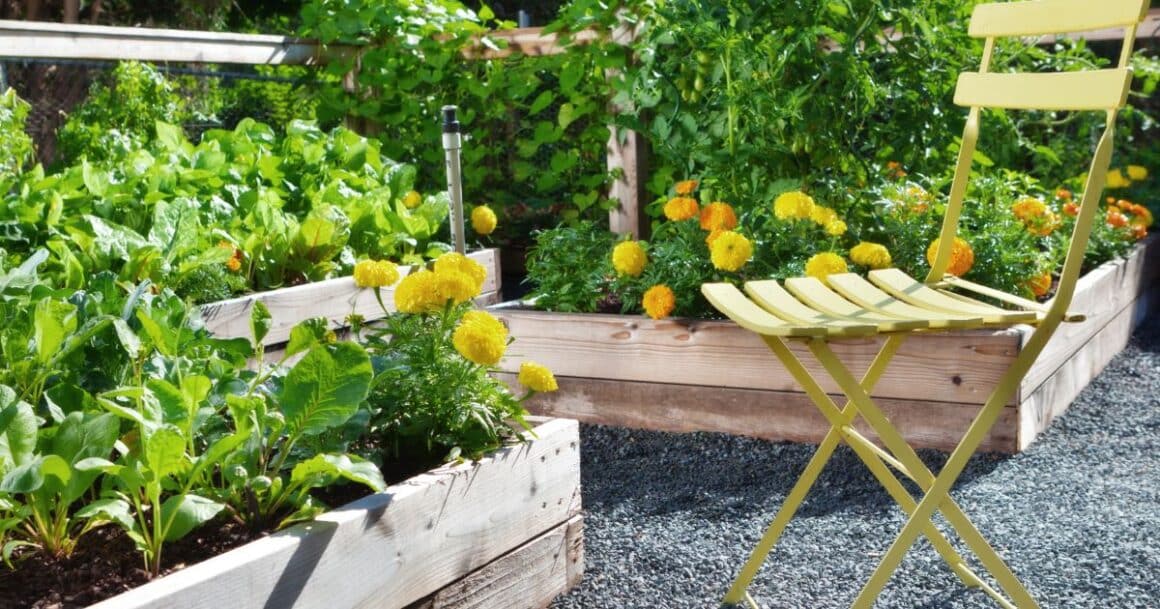
Step-by-Step Guide to Planting a Raised Garden Bed in Arizona:
1, Location, Location, Location
When placing a raised garden bed in Arizona, the location can make or break your gardening success.
The state’s intense sun, high temperatures, and unique climate conditions mean you must be strategic.
Let’s dive into the various variables and the best choices for bed placement:
Sunlight Exposure
General Rule: Most plants, especially vegetables, need a good 6-8 hours of sunlight daily. However, Arizona’s sun is not just any sun—it’s pretty intense, so the morning sun is always best. 🙂
Find a location that gets morning sunlight and has some protection from the harsh afternoon sun, especially during the peak summer months.
An east or southeast-facing location can be ideal. If that’s impossible, consider adding shade or planting taller plants on the west side to provide some afternoon shade.
Wind Protection
Arizona can experience strong winds, which can dry and damage plants. If you have a spot shielded by a wall, fence, or even some large shrubs, that can be a great location.
If not, think about adding some windbreaks or barriers.
Soil and Drainage:
While the soil in the raised bed will be imported, the ground underneath still matters. You want to ensure good drainage to prevent root rot.
Avoid placing your bed in a low spot where water might accumulate. If unsure, observe the area during a rainstorm to see how water behaves.
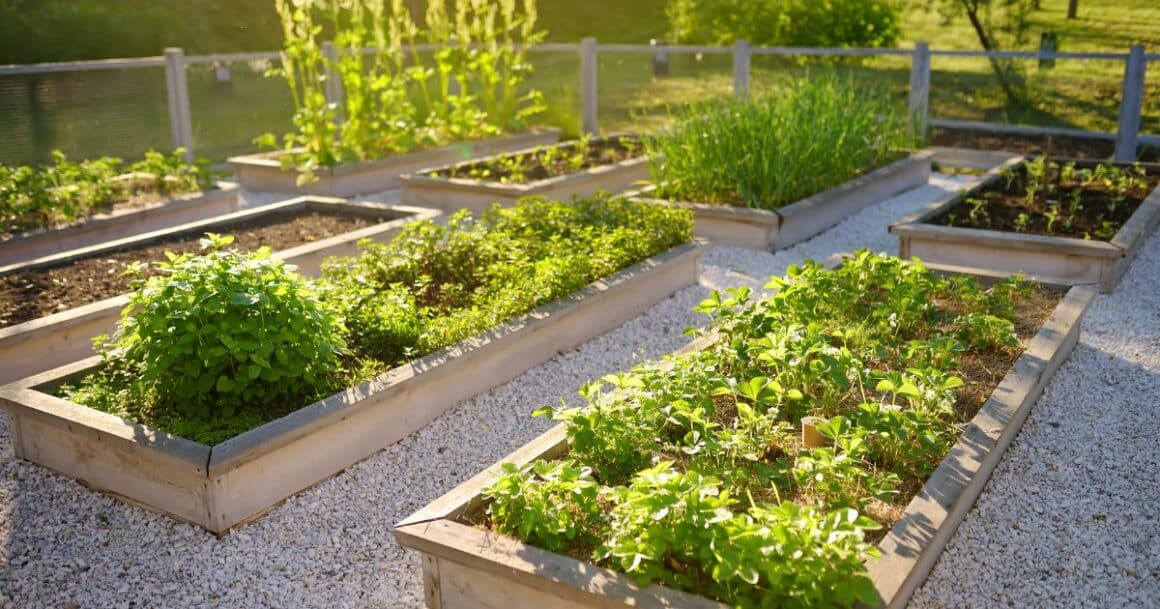
2. Chose a Frame for Raised garden bed
The frame of your raised garden bed is like the foundation of a house. It sets the stage for everything else.
Given Arizona’s unique climate and conditions, choosing a suitable material is even more crucial.
With the popularity of raised garden beds, there are many choices for frames, including wood, galvanized metal, and frames made of rot-resistant materials.
Let’s break down the most popular choices for raised garden bed frames:
Wooden Raised Garden Beds
These frames are made of all-wood construction, typically using redwood, pine, Douglas Fir, and cedar wood.
Pros of using a wood frame for raised bed gardening: Natural Look: Blends seamlessly into most garden landscapes.
Cons of using a wood frame for raised bed gardening: Decomposition, pests, and treated wood concerns.
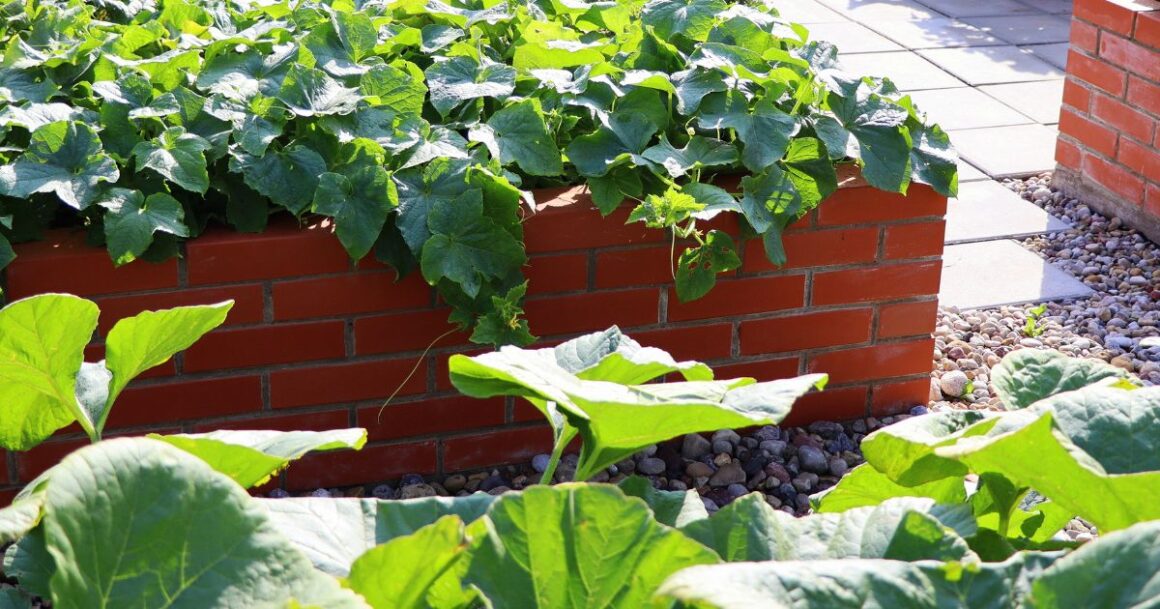
Concrete Blocks or Brick Raised Garden Beds
Concrete blocks or bricks offer several advantages when considering materials for garden beds.
They are durable, ensuring they won’t rot or degrade over time.
Their modular nature means it’s easy to resize or reshape your garden bed as needs change.
These materials have a thermal mass quality, allowing them to absorb heat during the day and release it at night, which can benefit plants in cooler temperatures.
However, there are some drawbacks. Aesthetically, some gardeners find them less appealing than wood.
They are also quite heavy, making it challenging for them to move. Furthermore, concrete has th
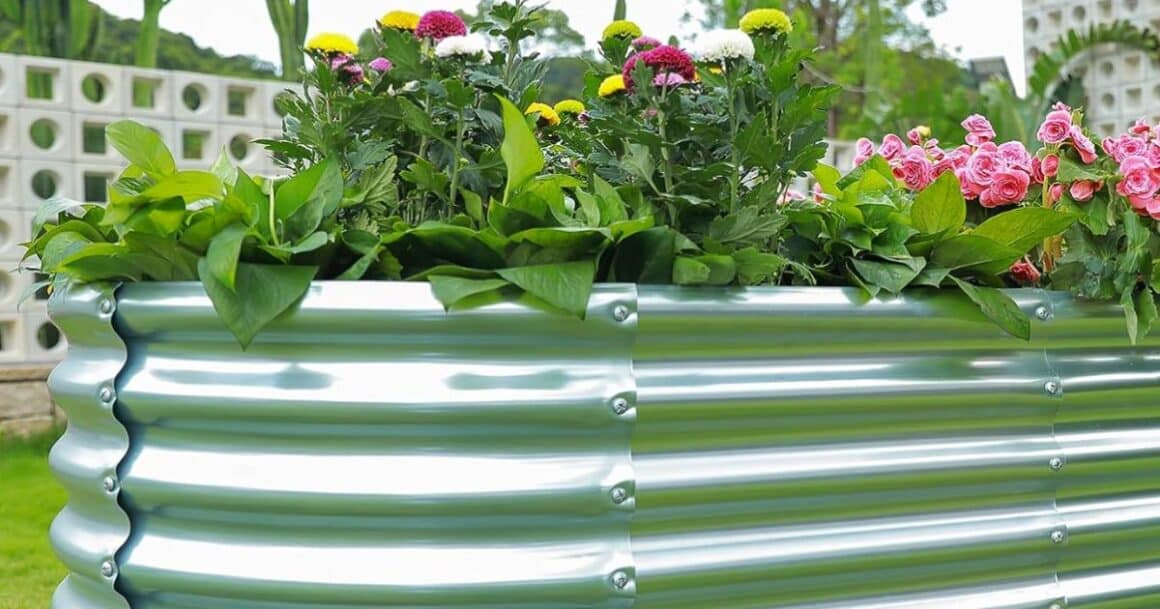
Galvanized Metal for raised beds
Using galvanized metal for raised beds comes with a set of distinct advantages and challenges. On the upside, this material is notably durable, offering resistance to both rot and pests. Additionally, it provides gardens with a sleek, contemporary aesthetic that many modern gardeners appreciate.
In regions with intense sunlight, like Arizona, the reflective properties of galvanized metal can be beneficial, preventing the soil from overheating by bouncing back some of the sun’s rays.
However, there are potential downsides to consider. The metal’s heat conduction can cause it to become extremely hot, potentially affecting the root zones during the peak of summer.
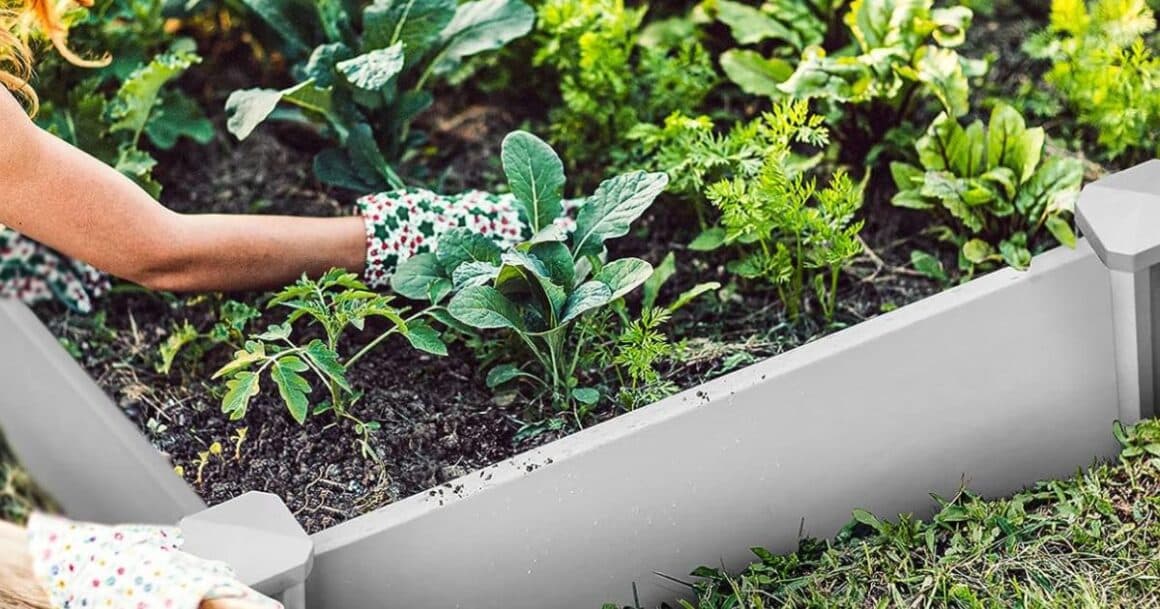
Plastic or Composite Frames for raised garden beds
When considering materials for raised bed garden setups, plastic has several advantages.
It’s notably lightweight, making it easier to move and set up. Additionally, plastic is resistant to rot and pests, ensuring it won’t degrade quickly or become a magnet for unwanted critters.
A further benefit is its variety; plastic garden materials come in various colors and designs to suit different aesthetic preferences.
However, there are some potential drawbacks.
Plastic might not have the same longevity as other materials, and its durability can be a concern.
Moreover, from an environmental standpoint, some gardeners are hesitant about using plastic due to sustainability concerns, preferring more eco-friendly options.
Shop the Best Raised Garden Beds:
3. Prep the Ground for Your Garden Beds
Prepping the ground and the bottom of your raised garden bed frame is a crucial step that can save you a lot of headaches down the road.
Let’s delve into the steps and materials you can use to prep for garden beds:
Clearing the Area and leveling the ground.
Before you even think about placing your frame, you’ll want to clear the area of any grass, weeds, or debris.
Leveling the ground ensures that your raised bed sits evenly, which is essential for consistent water distribution when you water your plants.
An uneven bed can lead to water pooling on one side.
Create a Barrier between the ground and garden bed soil.
Using Weed Prevention Cloth (Landscape Fabric)
This cloth’s primary purpose is to suppress weeds by acting as a barrier preventing weed seeds from germinating and growing while allowing water and air to penetrate and reach the soil.
This fabric reduces the need for frequent weeding, helps maintain soil moisture, and prevents erosion.
Using cardboard as a bed liner in raised garden beds (what I used)
Weed Suppression: Cardboard acts as a barrier, preventing weeds from growing up into the raised bed from the ground below.
Biodegradable: Over time, cardboard breaks down and decomposes, adding organic matter to the soil.
Moisture Retention: Cardboard can help retain moisture in the soil, reducing the need for frequent watering.
Pest Deterrence: It can act as a physical barrier against certain pests, like worms and nematodes, from entering the bed below.
Cost-Effective: It’s a great way to recycle used cardboard boxes, making it a cost-effective solution.
Worm Attraction: As cardboard decomposes, it can attract beneficial earthworms, which aerate the soil and contribute to its fertility.
Considerations before using cardboard as a raised garden bed liner:
Preparation: Before laying down cardboard, remove any tape, stickers, or staples.
Layering: For better weed suppression, you can layer multiple cardboard sheets.
Drainage: Cardboard is permeable and will allow water to pass through, but if you’re using it with other materials, ensure adequate drainage to prevent excess water build-up.
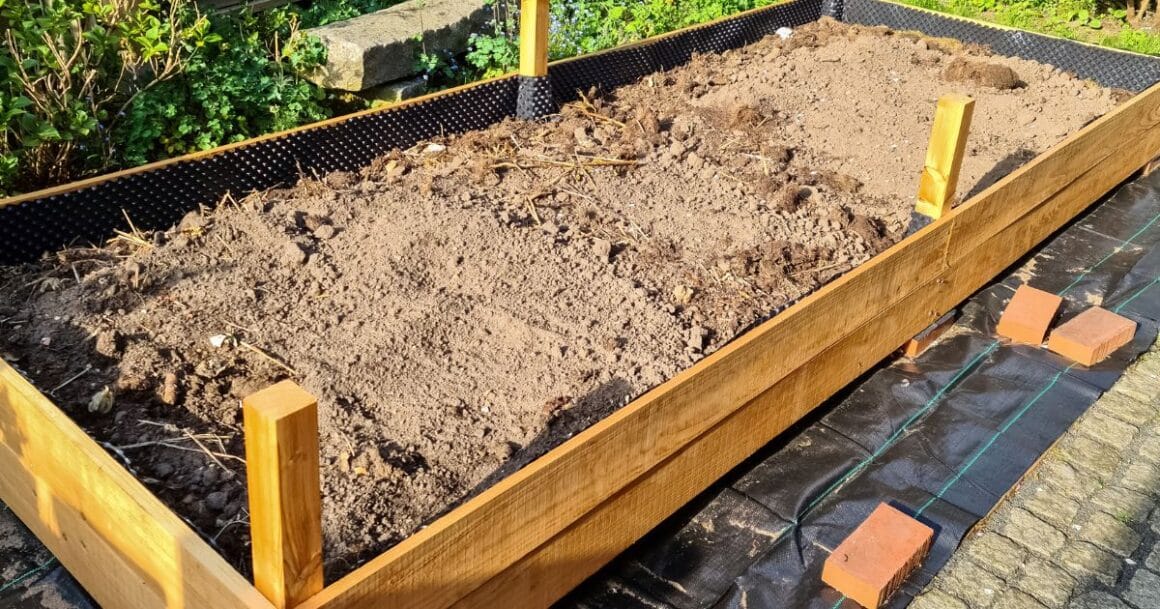
4. Choose the Best Soil for Your Raised Bed Garden
choosing the right mix can make a world of difference in the health and productivity of your plants.
Given Arizona’s arid climate and native alkaline soil (source)
- Moisture Retention: Ingredients like coconut coir or peat moss are crucial to help the soil retain moisture.
- pH Levels: Arizona’s native soil tends to be alkaline. Depending on your planting, you might need to adjust the pH. Regularly test your soil and adjust as needed.
The Best Soil Combination for Raised garden beds
At a high level, good garden soil is typically composed of three main components:
- Sand: Provides proper drainage and aeration.
- Silt: Holds water and is packed with minerals.
- Clay: Retains moisture and nutrients but can impede drainage if in high amounts.
The ideal garden soil, often called “loamy soil,” strikes a balance between these components, offering good drainage, nutrient retention, and structure. (source)
Organic pre-mixed soil for Raised Bed gardens
Organic pre-mixed garden bed soil is a top choice for many gardeners, and it’s easy to see why.
Made from naturally decomposed plant and animal matter, it offers a nutrient-rich environment essential for plant growth.
Its structure ensures good aeration while retaining the right amount of moisture, making it ideal for plants roots health.
Environmentally, it’s a win-win. Organic soil is sustainable, biodegradable, and free from synthetic chemicals, ensuring we’re kind to the earth while we garden.
Plus, it’s a haven for earthworms and beneficial insects, further enhancing soil quality and plant health.
Organic pre-mixed soil for Raised Bed gardens
Organic pre-mixed garden bed soil is a top choice for many gardeners, and it’s easy to see why.
Made from naturally decomposed plant and animal matter, it offers a nutrient-rich environment essential for plant growth.
Its structure ensures good aeration while retaining the right amount of moisture, making it ideal for plants roots health.
Environmentally, it’s a win-win. Organic soil is sustainable, biodegradable, and free from synthetic chemicals, ensuring we’re kind to the earth while we garden.
Plus, it’s a haven for earthworms and beneficial insects, further enhancing soil quality and plant health.
DIY Soil Mix for raised garden beds
Many gardeners mix their soil to have more control over its composition. A popular recipe is the “Mel’s Mix” from the Square Foot Gardening method, which includes:
- 1/3 Compost: Provides organic matter and nutrients. Ideally, mix different compost sources (e.g., mushroom, manure, vegetable).
- 1/3 Peat Moss or Coconut Coir: Improves water retention and soil structure.
- 1/3 Coarse Vermiculite or Perlite: Enhances aeration and for proper drainage.
Soil Amendments for Raised Garden Beds
Depending on the plants you’re growing and the base soil you’re starting with, you might need to add specific amendments:
- Compost: Adds organic matter and nutrients. Regularly adding compost can rejuvenate tired soil.
- Bone Meal: A natural source of phosphorus, great for flowering plants.
- Worm Castings: A rich source of nutrients and beneficial microbes.
- Lime or Sulfur: Used to adjust soil pH. Lime raises pH (makes the soil more alkaline), while sulfur lowers it (makes it more acidic).
- Mulch: adding mulch to the top of the soil (after planting) is great to help regulate soil temperature, retain moisture levels, and suppress weeds.
Growing plants in raised garden beds can use wood chips, pine needles, and other organic material from a compost bin.
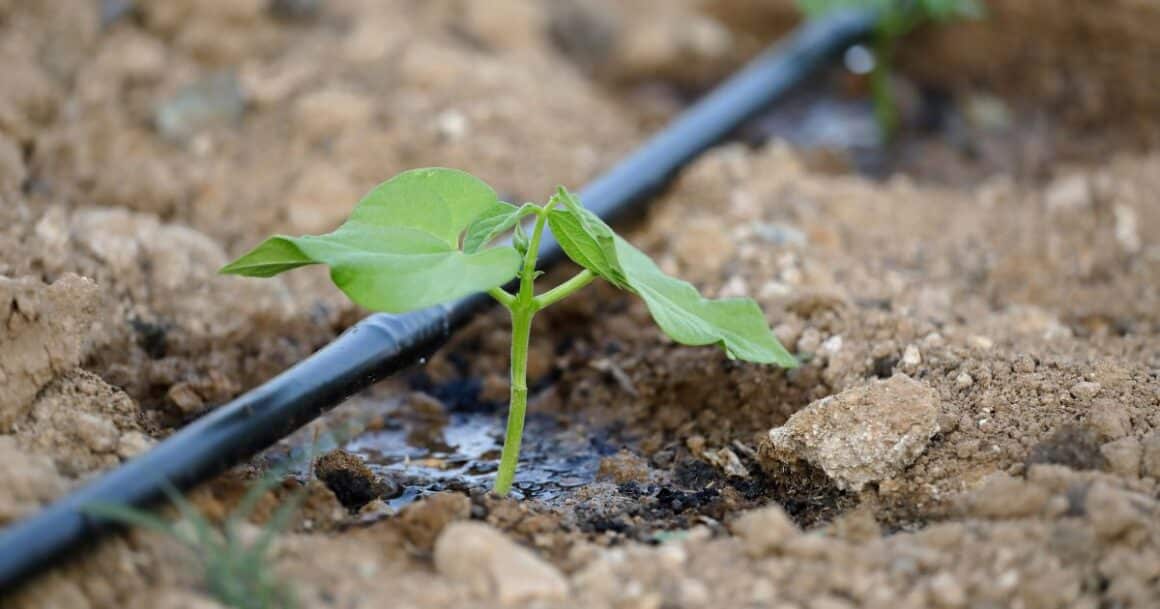
5. Choose a Watering System for a Raised Bed Garden
Watering is especially crucial in Arizona, where the arid climate can challenge even the most seasoned gardeners.
Raised garden beds, with their enhanced drainage, can dry out even faster. Let’s delve into the best watering systems for raised garden beds in Arizona:
Drip Irrigation System
A drip irrigation system delivers water directly to the base of plants, ensuring efficient and consistent hydration.
It’s especially popular for garden bed watering needs due to its precision and water-saving benefits.
I use a Drip Irrigation System for my garden beds because it makes caring for my garden much easier than watering with a soaker hose or by hand.
Soaker Hoses
Soaker hoses are porous tubes that release water along their length, providing consistent and even moisture to the garden bed.
Laid on the surface or slightly buried, they’re beneficial for densely planted areas or rows of plants.
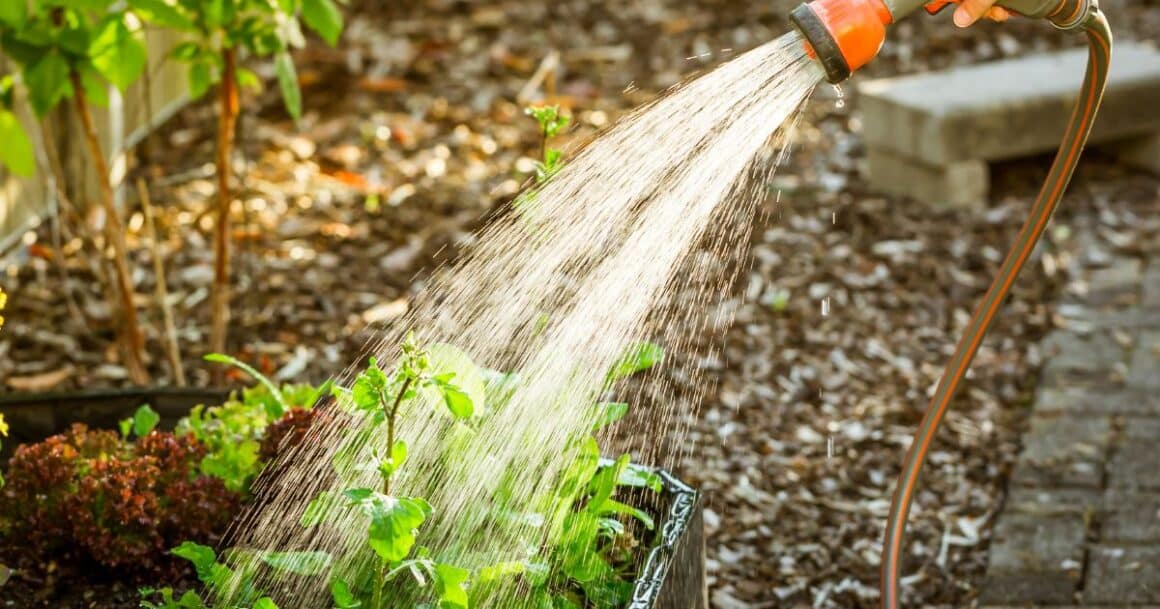
Watering by Hand
Watering by Hand involves manually using a watering can or hose to water plants.
It offers the gardener control over the amount and location of water delivery.
While it can be therapeutic and allows for close inspection of plants, it can be time-consuming and less consistent in water distribution, especially in larger gardens.
When I started my raised garden bed, I hand-watered. But not for long. It’s a pain and wasn’t sustainable for me.
In Arizona’s hot and dry climate, a drip irrigation system is considered the best option for raised garden beds due to its efficiency and precision.

6. Plant the Best Plants for Raised Garden Beds in Arizona
Arizona’s unique climate, characterized by hot summers and mild winters, offers opportunities to grow various plants.
However, it’s essential to choose plants for your raised beds that can thrive in the state’s specific conditions.
Here’s a list of some of the best plants raised beds in Arizona:
Grow Vegetables
Growing vegetables can be a very rewarding experience if you plant vegetables that typically do well in warmer climates.
Here is a list of vegetables I grow in my raised garden beds.
- Tomatoes: Opt for heat-tolerant varieties like ‘Heatmaster,’ ‘Solar Fire,’ or ‘Sun Gold.’ (source)
- Peppers: Peppers love hot climates! Both sweet and hot peppers can thrive, especially in the warmer months. I have so many jalapenos in my garden beds that I don’t know what to do with them all!
- Eggplants: These love the heat and are well-suited for Arizona’s climate.
- Melons: Watermelons, cantaloupes, and honeydews can do well with proper care.
FYI: You need ample planting space, so word to the wise: make sure you’ve got ample room before planting melons or pumpkins. - Leafy Greens: In the cooler months, consider planting lettuce, spinach, kale, and Swiss chard. My lettuce crop kept us in salad throughout the growing season!
- Root Vegetables: Carrots, beets, and radishes can be grown in the cooler seasons.

Grow Herbs
I use about a third of my gardening space to grow herbs. I grow basil, rosemary, oregano, cilantro, lavender and, mint in my Arizona Garden beds with great success!
Related article: The Best Herbs to Grow in Arizona + How to Grow Basil in Arizona
Grow Flowers
I love to plant flowers do well alongside of vegies and herbs in my raised garden beds. And they help with cross pollination, which is a huge plus!
- Sunflowers: These towering beauties love the sun and don’t seem to mind the extreme temperatures of summer, making them perfect for my Arizona garden beds. I plant sunflowers to help shade plants that require more shade.
- Marigolds: Not only are they vibrant, but they also help repel pests, and they do well in hot climates.
- Zinnias: These colorful plants are heat-tolerant and can brighten up any garden.
- Vincas: These are the most weather-resistant flowers I have ever seen! These are the best annual flowers for raised garden beds or any container gardens in the desert.
- Snap Dragons: You can plant snapdragons in the winter, and they will thrive in the Arizona climate until late April.
More Tips for Starting a Raised Garden Bed in Arizona:
Planting Season
Remember that Arizona’s planting seasons might be different from other regions. Many plants that are traditionally grown in the summer in cooler climates might be better suited for Arizona’s fall or spring.
We live in Phoenix (the lower desert), and we have extreme temperatures in the summertime, so I usually don’t plant anything after April.
Think Shade
During the intense heat of summer, even heat-loving plants can benefit from some afternoon shade.
Consider using shade cloth or planting taller plants to the west of shorter ones to provide natural shading.
Proper Drainage
Ensure your soil is well-amended and has proper drainage. So that your beds don’t collect excess water which will cause root rot in larger plants like tomatoes.
Money saving tip
Save yourself some money and grow your plants from seed! In the warmer climate, you don’t have to start seeds inside.
I buy seed packets at the hardware store or Walmart for a song compared to buying seedlings.
Related Gardening Articles
Conclusion: Arizona gardening: Raised Beds
In conclusion, cultivating a raised bed garden in Arizona presents unique challenges due to the state’s warm climate, but with the right strategies and tools, desert gardening can be a rewarding adventure.
With a bit of planning and these step-by-step tips as your guide, you’ll be rocking a raised garden bed, Arizona style, in no time!
And your raised bed garden will flourish, yield bountiful harvests, and bring endless joy for years to come!
I wish you the best of luck in your gardening endeavors!

I’ve been keeping it real since 1963. 😊
I’m a child of God, devoted wife, proud mama and grandma, full-time creative, domestic engineer, and passionate self-care enthusiast.
I’m purpose-driven and do my best to live each day with intention—whether shopping for treasures, painting in my art studio, digging in the garden, or cooking up something yummy for my family.
I’m always up for a good chat and love collaborating with fellow creatives and brands.
Let’s connect—don’t be shy!


